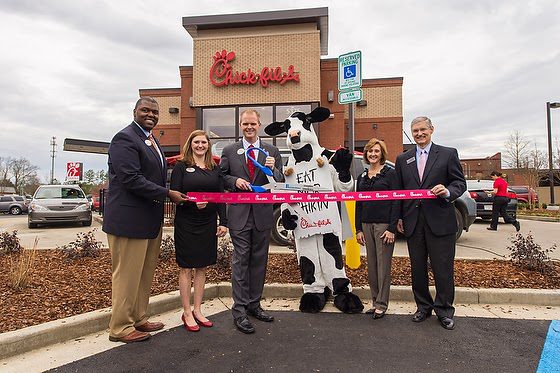| Nikon D4, AF-S NIKKOR 14-24mm f/2.8G ED, ISO 250, ƒ/8, 1/250 |
This week I have been covering the grand opening of the brand new Chick-fil-A in Birmingham, Alabama.
 |
| Nikon D750, AF-S NIKKOR 28-300mm f/3.5-5.6G ED VR, ISO 12800, ƒ/5.6, 1/80 ***4:13 a.m. EST*** |
One of the fun yet not-so-fun things is waking up to capture Dan Cathy playing Reveille, which is a bugle call, trumpet call, or pipes call most often associated with the military, waking up military personnel at sunrise. Dan used it to wake up all the First 100 overnight campers.
 |
| Nikon D4, AF-S NIKKOR 14-24mm f/2.8G ED, ISO 12800, ƒ/5, 1/20 |
People lined up 24 hours earlier, and then because there were so many, they had a raffle drawing to pick the first 100 customers.
 |
| Nikon D4, AF-S NIKKOR 14-24mm f/2.8G ED, ISO 3200, ƒ/5, 1/60—Off camera fill-flash using the Nikon SB-900 & SB800. A radio transmitter on the camera is triggering the Flash. |
People played all types of games to fill the time. Here some are playing corn hole.
 |
| Nikon D4, AF-S NIKKOR 14-24mm f/2.8G ED, ISO 12800, ƒ/5.6, 1/25 |
- 2 – Nikon D4 Cameras
- 1 – Nikon D750
- AF-S NIKKOR 14-24mm f/2.8G ED, Nikon D750
- AF-S NIKKOR 28-300mm f/3.5-5.6G ED VR
- Nikon 85mm ƒ/1.8G
- Sigma APO 70-200mm F2.8 EX DG OS HSM
- Nikon SB800
- Nikon SB900
- Pocketwizard kit, TT1, AC3, 2–TT5
- 2 – Interfit Metal Umbrella Bracket with Adjustable Flash Shoe
- 2 – Manfrotto 5001B Nano Black Light Stand – 6.2′ (1.9m)
- 2 – CowboyStudio 43-Inch Black and White Umbrella for Photography and Video Lighting Reflective
- Røde Video Pro microphone
- Shure FP15/83 Lavalier Wireless System
- ExpoDisc
- Eneloop XX batteries
- Gitzo GT-0531 Mountaineer 6X Carbon Fiber tripod
- ProMaster XC525 Tripod
- ThinkTank Airport Security™ V 2.0 Rolling Camera Bag
- Zacuto Z-Finder, Gorilla Plate V2, and Z-Finder 3.2″ Mounting Frame for Tall DSLR Bodies
- Beats by Dr. Dre Solo HD On-Ear Compact Folding Headphones
 |
| Nikon D750, Nikon 85mm ƒ/1.8G, ISO 720, ƒ/1.8, 1/250 |
 |
| Nikon D4, AF-S NIKKOR 14-24mm f/2.8G ED, ISO 12800, ƒ/2.8, 1/60 |
Slow down and remain calm – “Hey photographer, can you come and capture this for us?” is asked so often at events that this is what I call planning for the unexpected.
The unexpected is when being prepared is still not enough. It isn’t on the run of the show and requires you to adjust. Be sure you are fully aware of the timeline and your main objective. Be sure that getting this quick grab shot doesn’t risk meeting the primary goal.
The most thing that gets under my skin the most is the unexpected. The reason is pretty simple. The difference between good and bad photography lies in the preparation.
What often happens is I am in the middle of setting up for something that requires me to put my cameras into a particular setup. The best example is doing a video with my Nikon D4 cameras. There are so many setting changes that I have them now memorized and saved in the Shooting Memory Bank as VIDEO.
I am in manual mode, and the autofocus to manual focus are two things I can think of right away that are not how I would shoot stills. Cameras have microphones on them, and they are on tripods. If someone were to ask me to shoot something right in the middle of this setup, I have to explain it will take me a good five minutes to be ready, and then I will need more time to set up once again for the video interview I am doing.
When this happens, it isn’t the client but someone else who thinks I am there to capture everything anyone will want.
“I would love to get that photo for you. Can you give me just one minute to make some changes with my gear?” I typically try to say when asked for the unexpected. I only say this when I need a moment to change the gear. “I am sorry, but I need to be getting what I am working on right now for _____________ [insert client’s name] that I was to do for them. I have your shot list I am working on. What can I cut to get this photo?” it is also just as appropriate.
If hiring a photographer, give them a shot list before you sign the contract. Remember, when you ask for those last-minute photos, the professional photographer needs time to adjust–this is why you hired them to remember. If it were that easy, then your smartphone would have sufficed.
Now back to the photographer. Be sure when you are saying no that the reason is that you cannot meet your primary objective versus just being unwilling to be inconvenienced. Do this too much, and you will not appear to be there doing all you can to help the client.
My third camera is often set up for quick reaction to about anything: Auto White Balance, Auto ISO, and autofocus settings for face recognition. I typically use the Nikon D750 for this camera. It has a popup flash, just in case I need it.
Remember, when people ask you to do something at the spur of the moment, do your best to accommodate them, but also let them know you may need a moment to get ready.

